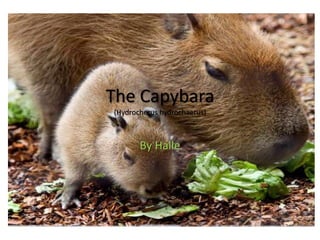
Capybara[1]
- 1. The Capybara(Hydrocherushydrochaerus) By Halle
- 3. It’s hair is Reddish-Brown, Light or Yellow brown, and Gray
- 4. Capybaras are usually four feet long, twenty-one inches high, and can weigh from 100 to 150 lbs.
- 6. Food What do Capybara eat? Capybara eat a variety of things like Aquatic plants, grass, cereal, fruit and melons. Capybara are herbivores, which means they don’t eat meat. Who are the Capybara predators? The predators of the Capybara on land are pumas, ocelots, jaguars, cougars, and anacondas (snake) It’s predator in the water is the Caiman.
- 7. Physical Adaptations Capybara have webbed feet for swimming actively or when in danger. The Capybaras eyes, ears, and nose are on top of it’s head for seeing and breathing while swimming. Like other rodents, the Capybara has long teeth that always grow for eating bark or harder foods. Male Capybara have scent gland on their nose to mark their territory. Capybara have fatty tissue or blubber that gives them a buoyancy in the water while swimming. The Capybaras have a Digestion Chamber to ingest more protean and nutrients. The Capybara has hair that dries quickly when out of water. Capybaras have short claws that help them move easier over the hard terrain they live on. Capybaras have short legs that help them swim fast and glide through the water. The Capybara has 3 toes on it’s back legs and 4 toes on it’s front legs that help with crossing terrain and swimming.
- 8. Behavioral Adaptations Capybara make many sounds like whistles, grunts, clicks, and purrs to warn the group of danger and to communicate. When in danger, Capybaras go in the water and surround their young to stay safe from the on-land predators. Capybara will stay underwater for about five minutes when a predator is threatening them. A capybara has the ability to press it’s ears against it’s head to keep water out while swimming. Capybaras are social animals which helps them because they stay in groups for protection.
- 9. Zoo Observations What was the size of the habitat at the zoo? The habitat was about four times the size of my room What did it look like? The Capybara habitat was a room with surrounding rock formations and trees. It was enclosed by glass. The floor on the ground was made of wood chips. The shelter was masses of rock and logs. The habitat wasn’t really clean but it was still nice. What other animals shared the habitat? There were three other animals in the habitat. The animals were a Scarlet Macaw, the Roseate Spoonbill, a Pintail Duck, and anteaters. What were the food and water sources? There was alfalfa hay laid out on the ground for the Capybara. There was also a small watering hole. Anything else? The Capybaras in the habitat were either laying down or walking around. There were three Capybara in the habitat.
- 10. Habitat Changes In the Capybara habitat, I would make a bigger and deeper watering hole because Capybaras like to swim and spend most of their lives in the water I would add more light to the habitat of the Capybara because it lives right by the equator and they get a lot of sunlight by the equator. I would lay down grass and dirt along with the wood chips for the Capybara because in the habitat for it in the wild, there are many different terrains, like dirt and grass. I would give the Capybara more room to move around in because they are territorial animals. Their territory is 200 acres at the least, so they need more room. I would add a river of running water because the Capybara likes to spend time in rivers and mate in rivers.
- 11. Interesting Facts Did you know? The scientific name, Hydrocherushydrochaerus, means ‘water pig’ and the word Capybara means ‘master of the grass. Capybaras are very good swimmers, and can survive up to 5 minutes in the water. Capybaras eat their own poop.
- 12. Taxonomy Family: Hydrochaeridae Order: Rodentia Class: Mammalia Phylum: Chordates-11 Kingdom: Animal
- 13. Thank you! Thank you! Thanks! Thanks! Thank you! Thank you ! Thanks! Thanks! Thank you!
- 14. Bibliography www.library.thinkquest.org www.zooborns.com www.rebsig.com
- 15. Capybara